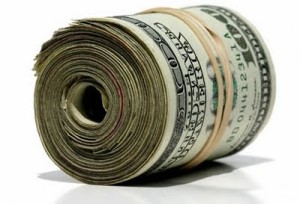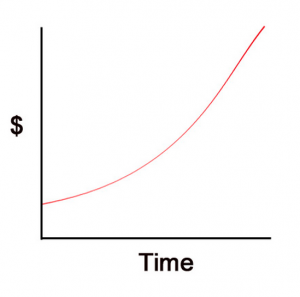Statistically speaking even if you are a very good poker player, with a huge bankroll, there is a chance that you will eventually run so bad that you will go broke. Unfortunately we can’t eliminate that probability completely but we can reduce it. Common practise is to have a bankroll of 300 big bets if your game is limit hold’em.
But where does this 300 big bets strategy come from? Do I always need to drop down a level when I lose so much that I only have 300 big bets for the next level down? There are no simple answers to these questions. I try to understand how my bankroll behaves statistically so that I feel more comfortable with my bankroll strategy. I find it easier to think about some of the concepts in very simple non-poker terms first.
Lets look at some statistical ideas associated with bankroll management:
- Going broke in a simple game
- Estimating my earn rate
- Variation in my earn rate
- Probability Distribution functions
- Short term swings
1. Going broke in a simple game
Game Theory is a branch of statistics, which unsurprisingly looks at statistical problems associated with games. One of the most well known problems is the “gamblers ruin” problem. What is the probability that a gambler, playing a particular game, will go broke and when is that likely to happen? Obviously the more complex the game in question the more complex the calculation. Before the advent of computers, that are able to run large scale simulations, statisticians would get very excited about fancy equations and methods to estimate the answers to these questions.
Let’s look at the simplest example. There is a game called “lucky coins” where you play against the house. You walk up to the table with a pound coin, the dealer tosses it and if its heads he keeps it and if its tails you keep it and he gives you another one (I am using pounds rather than dollars because I am English and its easier to conceptualise tossing coins than it is to conceptualise tossing notes). If you have a bankroll of £100 and the house also has a bankroll of £100 and you play until one of you is broke then it should be obvious that you have a 50% chance of going broke. If you have £100 and they have £300 then you have a 75% chance of going broke… do you see how that is so?
In fact this problem breaks down to a very simple formula:
Probability of going broke = their bankroll/(your bankroll + their bankroll)
There is an interesting result in here. When you play against the house in this break even game your chances of going broke are in proportion to the size of your bankroll compared to theirs. This gives the house a great advantage because for all intent and purposes their bankroll is infinite compared to most peoples’. They win in the long run because the games are statistically skewed in their favour and because they have more money.
2. Estimating my earn rate
In Limit Hold’em your historic (or past) earn rate is very easy to calculate.
Earn rate per hour = Total amount earned/number of hours played.
Earn rate per hundred hands = Total amount earned×100/number of hands played.
Earn rate per hand = Total amount earned/number of hands played.
I like the second one best and the common practice is to divide this number by the amount of the big bet to get a rate per hundred expressed in big bets. You need to have a lot of hands for this to be meaningful. It is also a useful starting point to estimate your expected future earn rate. However, hopefully you will be improving your play all the time so this wont really be a static number that you can ever define exactly.
3. Variation in my earn rate
Variation is a much more tricky statistic to define
If your game is “lucky coins” then your expected earn rate per toss is zero. Half the time you win £1 and half the time you lose £1. But you will never ever earn zero on a single toss! So your actual earn rate on a single hand is never equal to your expected earn rate and the variation between the two possible amounts you could earn is huge.
In poker your actual amount earned over a hundred hands will very rarely be equal to your long term earn rate. Sometimes it will be negative and sometimes positive. If you are a winning player then in the long run the positives will more than cancel out the negatives. In order to use statistical equations to develop our bankroll strategy we need to define this variation. The term that statisticians use is “statistical standard deviation”, they have equations that define it mathematically. They also multiply this number by itself and call it “statistical variance”. Poker Players call it “swing” which I think is a much more groovy word.
4. Probability Distribution functions
A good way to visualise how variable something like earn rate is, is to plot the likelihood of the various possible outcomes.
Lets do this for “lucky coins”. Lets say you decide to play ten tosses and then stop. How much could you expect to earn? These are the probabilities of each possible outcome:
|
Number of wins |
probability |
|
0 |
0.1% |
|
1 |
1.0% |
|
2 |
4.4% |
|
3 |
11.7% |
|
4 |
20.5% |
|
5 |
24.6% |
|
6 |
20.5% |
|
7 |
11.7% |
|
8 |
4.4% |
|
9 |
1.0% |
|
10 |
0.1% |
If we graphed this it would look like this:

So if your gambling strategy is to play exactly 10 tosses of lucky coins every time you visited a casino and then stop… you would break even about one time in 4…. You would double up (and go broke) one time in a thousand etc… The most likely outcome is that you win 5 and lose 5 which is what we would expect.
Statisticians call this a binomial distribution because only two things can happen each time (either you win or lose).
Now the binomial distribution is the simplest of all the statistical distributions. Not many things that statisticians (or poker players) want to study are simple enough to model using this distribution.
One of the most useful (and well known) statistical models is the normal distribution.
It is probably better known by the shape of its graph, the bell curve:

This is used for lots of things. Exams scores are often “normalised” which means that they are adjusted so that they follow the shape of this distribution. Heights of people are normally distributed, there are a few really short and a few really tall people, but most people are somewhere in the middle. In fact statisticians (and scientists and doctors and engineers but not lawyers) assume that any random variable is normally distributed (until they are proved otherwise). So the current general assumption amongst poker professionals is that poker earn rate is normally distributed.
If your game is limit hold’em and your earn rate per hundred hands is 2 big bets and your standard deviation is 19… and you wrote down how much you earned after each 100 hands… and then worked out how frequently you earned each amount….. and then plotted those numbers…. then you would get a graph that looks like the one above .
(2 and 19 are considered to be very reasonable statistics for a good Hold’em player)
But how would you know what your standard deviation is? Well you could plot the graph and then measure it. You would do this by comparing it to graphs drawn according to the probability density function for the normal distribution:
You could also use what are known as “regression techniques” to arithmetically estimate your average earn rate and standard deviation from your raw data.
Thank heavens we no longer have to do this because these days computers will do it for you. If you play online and use Poker Tracker it will calculate these parameters for you.
The three curves below show how variable the amount you can expect to earn is, per 100 hands, for different standard deviations. They all have the same average earn rate, 2 big bets per 100 hands.

4. Short term swings
If I have a session where I lose 30 big bets in the first hundred hands I try not to be disheartened. I endeavour to continue to make correct poker decisions and remember that graph. Although, thankfully it doesn’t happen that often, a 30 big bet loss in the first 100 hands is not beyond the realm of possibilities, or indeed probabilities.
Likewise when I win 30 big bets or more in the first 100 hands I don’t let myself think that I am the best poker player ever. It’s all natural within expected variance.
In fact if your average earn rate is 2 bb/100 and your sd is 19 then in your first 100 hands you would expect to:
- lose 30 big bets or more one session in every 22
- win 30 big bets or more one session in every 14
- be in profit only 54% of the time.
So what should my bankroll strategy be?
Obviously the most important thing to do to minimise the chances of going broke is to make correct poker decisions hand by hand, street by street. There is no magic formula or mathematical proof that can determine a perfect or “correct” bankroll strategy. Your bankroll strategy will decide the level/limit that you play at. These are some of the principles you should consider when determining your bankroll strategy.
- The amount you win or lose will vary in the short term. This is what brings players with less skill than you to the table, so variance should be revered not feared (but always respected).
- In the short term the dominant statistic is variance. In the long term, earn rate dominates.
- For Limit Hold’em most poker professionals consider 300 big bets to be the minimum (but sufficient) bankroll required to weather the short term swings. Similar consensus exists for other forms of poker. If you play another form then you should make yourself familiar with the prevailing advice.
- Seriously consider dropping down a level when you reach 300 big bets for the level below. If you do drop down, DO NOT lose respect for the game and your opponents because the bets look smaller.
- If you move up a level and get hammered it’s not always due to swing. You may not be ready. Move down again and rebuild your bankroll and your confidence.
- When your bankroll is vulnerable consider avoiding situations with high variance outcomes. I actively avoid playing with maniacs when my bankroll is low. By doing this I am giving up potential profit but also but I am also reducing the probability that I will have to drop down a level (which would definitely reduce my expected earnings in the long run). Playing scared against a maniac is probably not a terrific idea.
- Always protect your bankroll ahead of your ego.
The bankroll strategy that you employ will depend on your poker aims and on how much risk you are prepared to take. Hopefully some of these ideas have helped you understand the nature of that risk a little better.
Submit your review | |




